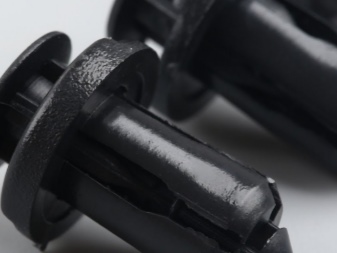Types and installation of plastic rivets

Knowledge of the types and order of installation of plastic rivets is very important for any car owner. The current review of plastic rivets for cars allows you to determine the choice of suitable products. And compliance with the rules for installing car rivets for holes of various kinds eliminates many problems with the vehicle.

Description
The conversation about plastic (plastic rivets) should start with the fact that they are all made of polyamide.
These fasteners provide a completely reliable installation, although they seem flimsy in appearance.

There are no special technical differences from typical blind rivets. Plastic constructions:
do not pass electric current, stray currents and static discharges;
absolutely resistant to corrosion processes;
are distinguished by an increased level of moisture resistance;
ideal for working with cardboard, plastic and fiberglass joining products.

Even with the continuous improvement of bolted and welded connections, rivets remain a highly sought after fastener. They are more attractive when exposed to shock or vibration. Technically, a plastic rivet is a short bar with a flat-convex head. In this case, the leg has an oblong shape. All rivets are permanently installed.


Where are they used?
Automotive plastic rivets are in demand primarily where it is impractical or extremely difficult to use similar metal products.... An important condition is also the absence of increased requirements for the strength of the fasteners. You need to focus on the materials that are available. It is worth considering that rivets are used not only for cars. They are used for holes in many other areas.

The use of such fasteners is very widespread in the construction industry. There he is appreciated for the ability to reliably install ventilated facades.
Fixation of sheet finishing materials on vertical surfaces is also provided. It is also worth mentioning the following industries and devices:
car building;
aircraft construction;
food industry;
radiators;
various household appliances (for example, fans, air conditioners);
separate parts of medical and food equipment.


What are they?
The rivet shank most often has a cavity, but this is not always the case. It is customary to distinguish between the following types of rivets:
spacer;
fluted;
petal;
cassette;
multi-clamp;
semi-hollow;
cylindrical;
conical;
secret;
semi-secret.
There are other types of plastic fasteners, but less often.


How to install?
Self-made plastic rivets can be obtained from ampoules or ballpoint pens. But you can also use many other types of sticks or tubes made of plastic. The plastic should be riveted using a soldering iron with a power of 25 to 400 watts. Together with it, a power regulating device is used.
For your information: the regulating block is also sometimes made by hand. In this case, the main component is a thyristor of suitable power. Without adjusting the power of the soldering iron, it will not be possible to choose the most effective temperature for melting the plasma mass, as a result of which the rivet can be burned and not melted.

Important: you will also have to redo the tip of the soldering iron tip. It must have the same configuration as the rivet heads.
The procedure consists of three stages:
a rivet is inserted into a prepared channel;
put a heated sting, press;
continue to work after solidification of the plastic.
The sting itself is first filed. In the middle, a recess is made with a drill. This is exactly what allows you to give the necessary shape. Round caps are easiest to form. They simply lean against the ball removed from the bearing and hit it lightly with a hammer (it is absolutely impossible to press it in).


How to install plastic rivets, see below.













The comment was sent successfully.